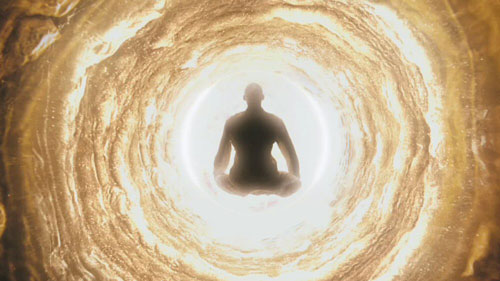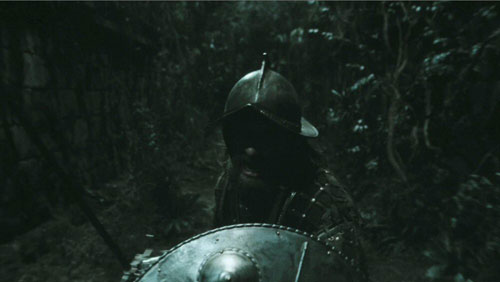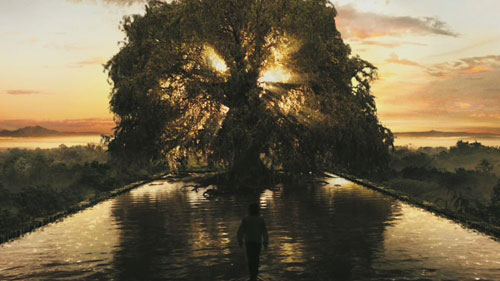
There’s a moment in the “space bubble” segment of The Fountain where I realized the tattoos on Hugh Jackman’s arms are counting off years, like the rings inside the tree sitting behind him. It’s one of those moments that sent shivers down my spine because of the way it combines concept, theme and imagery into one perfect visual moment. There are a lot of scenes like that in The Fountain, scenes filled with subtle revelations and understandings. I walked out of the film dumbstruck with awe, having just seen something brilliant.
Brilliant is really the only word I can use to describe the film. It took Darren Aronofsky years to get his movie made, but every day was worth it. The finished work is wonderful, is moving, is stunning. I may have walked out of the movie dumbstruck but I spent the next few days wishing I could talk to someone about it. The movie stayed in my mind; not just images (and there are so many gorgeous images), but ideas and themes. The narrative is complex but not overly complicated, and that complexity gives you the opportunity to keep turning aspects over in your mind, making the small connections and getting the satisfaction of taking it apart and putting it back together again. What’s most appealing about the narrative is how it treats the audience as adults – we’re not led step by step through everything, but at the same time things aren’t needlessly obscured just to preserve a sense of mystery or to give a cheap twist.

It’s been reported that there are three stories – this is sort of true and yet not true. The film’s core takes place in the here and now, with Hugh Jackman as a research scientist trying to find a cure for cancer. It’s personal for him – his wife, Rachel Weisz, is dying from a brain tumor. Jackman’s team brings back a sample from a unique tree in the South American jungle. and while experimenting with the bark of the tree, Jackman realizes he may have made an astonishing breakthrough. Meanwhile, Weisz is writing a novel about a conquistador (also played by Jackman) who travels to the New World to find the Biblical Tree of Life for his queen (also played by Weisz). The third strand of the story takes place in the far future, with Jackman (still playing the scientist) hurtling through space in a strange bubble, with only the South American tree to keep him company. At first the intercutting between the stories can be disorienting, but it all quickly makes sense, and by the end of the film the three strands come together in a magnificent way that rivals the narrative flow and tightness of any novel.
Thematically, The Fountain is a phenomenon. The difference between this and Requiem for a Dream – a film I unabashedly love but can rarely watch because it just makes me feel rotten – is galactic. Maturity is going to get thrown around a lot in reviews, and it’s fitting. The night before this screening I saw the new Altman film, A Prairie Home Companion, which is about issues of mortality as well. It’s interesting to see how an old master, with dozens of films under his belt, and a young whippersnapper, on just his third movie, approach the subject. The answer is the same way – with grace and acceptance. The end of The Fountain left me with an existential peace reminiscent of the way you feel after an intense meditation.
I know that I’m using lots of superlatives here. I would like to tone the rhetoric down, but it’s not rhetoric. It’s reality. I don’t want to create unreasonable expectations, but for me the question about The Fountain isn’t “Is this one of the best films made in decades?” but “What are the handful of films in my lifetime as beautiful and profound as this one?”
Aronofsky’s not up to his old tricks here – there’s no hip hop montage in this film. He’s up to new tricks; the rhythmic editing takes the hip hop montage concept out of the realm of film geek gimmick and turns it into a legitimate and exciting tool. He marries sound and cuts to give the film a subtle beat; it wasn’t until halfway through the movie that I realized what he was doing. Combined with The Fountain’s miraculously short running time, the editing gives what could have been a talking heads drama a very compelling energy.

It isn’t just the post-production work that gives it that energy, to be fair. The Fountain was once going to star Brad Pitt and Cate Blanchett, but after his funding fell through Aronofsky rebounded with Hugh Jackman and Rachel Weisz. I don’t know what a Pitt/Blanchett Fountain would have been like, but the one we have features two actors doing perhaps the best work of their careers. Weisz doesn’t play her dying character as a one-note weeper; she has levels of complexity, layers of fear and acceptance, that she is able to get across in a minimal amount of screentime. Weisz has gorgeous eyes, and she uses them to tell half her story.
The revelation is Jackman. We knew he was charismatic. We knew he could sing and dance. I, for one, didn’t know that he could be completely emotionally naked, flaying himself on screen down to his own bare essence. The scenes he plays as the conquistador are good. The scenes he plays in the modern day are affecting and moving. But it’s the scenes that he plays in the future that are brilliant. He’s sitting alone, bald, in a bubble with a tree amidst the vastness of intergalactic space, and yet he makes these scenes my favorite in the movie. In the bubble he’s a madman, a lost soul, a Buddha, all at once. Hugh Jackman has delivered a performance that demands an Academy Award nomination.
The Fountain is a low budget film – the original incarnation was budgeted at 75 million, while this one is only 35 million. Every now and again you can recognize the budget – the South American jungles in the 16th century feel a touch claustrophobic – but Aronofsky makes the budget work for him. The sets are small, but they have a warmth and realness. Even the closeness of the jungle feels like a story point, since this is the 16th century South American jungle in a novel, after all. But one place where the budget isn’t felt is in the special effects. In the final act the bubble drifts through the nebula, and the visuals serve as reminders that special effects can do more than sink big boats or destroy the Golden Gate Bridge. The nebula scenes in The Fountain evoke real wonder and awe.

All of that awe and wonder would be pointless if the movie didn’t have a serious emotional core. The film is thematically and conceptually dense, but it’s also emotionally rich; I’ve heard the film described as 2001 with a heart, and I don’t think that’s a terrible example. The relationship between Jackman and Weitz’s characters is completely real and totally fleshed out and developed. The actors have to represent a full, rich relationship while enacting the final three days of a very sick person’s life, but they cut through the easy pathos to present two people very believably and relatably in love.
There’s more to gush about – the score is incredible, and Ethan Suplee and Ellen Burstyn deliver tremendous supporting performances. There are a couple of incredible moments that I can’t wait to talk about once everyone has seen the film. The Fountain is the sort of movie that makes me want to write a book about it. What’s most important, though, is that The Fountain vaults Aronofsky to a new level as a filmmaker. Before he was a cult director, a fringe talent who appealed to the film geeks and the people who look to the edge. The Fountain’s not a mainstream movie – it’s really fucking smart, for one thing – but the director who made this movie is a man coming into his own. The Fountain is beautiful, gripping and utterly transcendent. It’s the best film of 2006.